
Astragalus is a large genus of over 3,000 species of herbs and small shrubs, belonging to the legume family Fabaceae and the subfamily Faboideae. It is the largest genus of plants in terms of described species. The genus is native to temperate regions of the Northern Hemisphere. Common names include milkvetch, locoweed and goat's-thorn. Some pale-flowered vetches are similar in appearance, but they are more vine-like than Astragalus.

Astragalus alpinus is a species of flowering plant in the legume family known by the common name alpine milkvetch. It has a circumpolar distribution, occurring throughout the upper latitudes of the Northern Hemisphere.
Astragalus anxius is a rare species of milkvetch known by the common names troubled milkvetch and Ash Valley milkvetch. It is endemic to northern Lassen County, California, where it is critically imperiled. It was formally described in 1992.

Astragalus asymmetricus is a species of milkvetch known by the common name San Joaquin milkvetch. It is endemic to California, where it grows in grassy and disturbed areas in the Central Valley and nearby parts of the Central Coast Ranges and San Francisco Bay Area.

Astragalus casei is a species of milkvetch known by the common name Case's milkvetch. It is native to the Mojave Desert and its sky island woodlands of eastern California and western Nevada.

Astragalus cimae is a species of milkvetch known by the common name Cima milkvetch. It is native to the Mojave Desert and its sky island woodlands of eastern California western Nevada, especially on calcareous soils, including the Cima Dome area in the Mojave National Preserve.
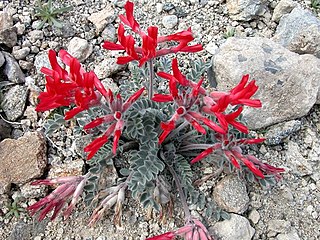
Astragalus coccineus is a species of milkvetch known by the common name scarlet locoweed or scarlet milkvetch. It is native to the deserts, scrub, and chaparral of the Southwestern United States in Arizona, California, and Nevada, and in northwestern Mexico.
Astragalus curtipes is a species of milkvetch known by the common name Morro milkvetch. It is endemic to the Central Coast of California, including the Morro Bay area in San Luis Obispo County.

Astragalus deanei is a rare species of milkvetch known by the common name Dean's milkvetch, or Deane's milkvetch. It is endemic to southern San Diego County, California, where it grows on the slopes of the Peninsular Ranges between El Cajon and Tecate.

Astragalus didymocarpus is a species of milkvetch known by the common names Dwarf white milkvetch and Two-seeded milkvetch. It is native to the southwestern United States and northern Mexico, where it can be found in many types of habitat.
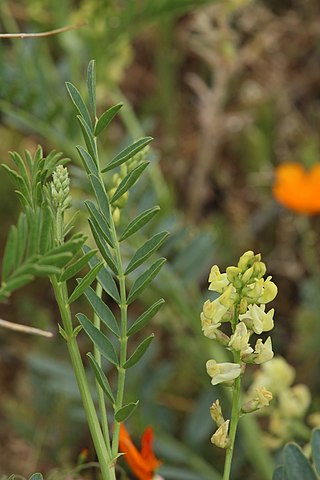
Astragalus douglasii is a species of milkvetch known by the common name Douglas's milkvetch. It is native to California and Baja California, where it can be found in many types of desert, valley, chaparral and woodlands, and montane habitats, usually below 8,000 feet (2,400 m) elevation.
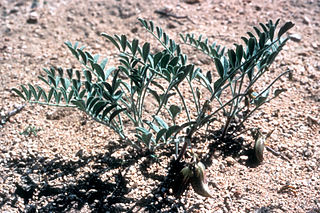
Astragalus ertterae is a rare species of milkvetch known by the common name Walker Pass milkvetch. It is endemic to California, where it is known from only three occurrences near Walker Pass in the Sierra Nevada. It is endangered by trampling, trail use, and also grazing.
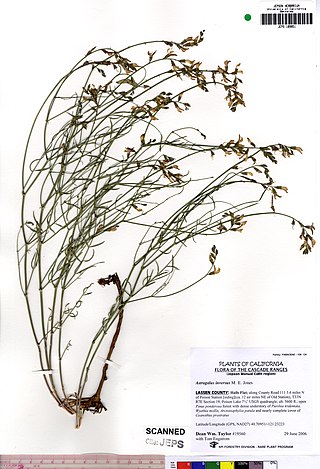
Astragalus inversus is a species of milkvetch known by the common name Susanville milkvetch.

Astragalus kentrophyta is a species of milkvetch known by the common name spiny milkvetch. It is native to western North America from central to west Canada, to California, to New Mexico. It grows in rocky mountainous areas, such as the Sierra Nevada, and on plateaus.
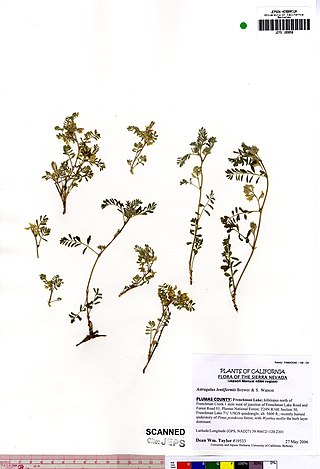
Astragalus lentiformis is a species of milkvetch known by the common name lens-pod milkvetch. It is endemic to the Sierra Nevada in eastern Plumas County, California, where it grows in chaparral scrub and coniferous forests.

Astragalus oophorus is a species of milkvetch known by the common name egg milkvetch. It is native to the western United States, mainly California and Nevada, though one variety can be found as far east as Colorado. It is a plant of sagebrush and other dry habitat.

Astragalus purshii is a species of milkvetch known by the common names woollypod milkvetch and Pursh's milkvetch.

Astragalus pycnostachyus is a species of milkvetch known by the common name marsh milkvetch. It is endemic to the coastline of California, where it grows in wet saline habitat such as marshes.
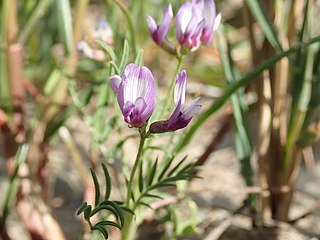
Astragalus tener is a species of milkvetch known by the common name alkali milkvetch. It is endemic to California, where it grows in both coastal and inland areas such as the Central Valley, especially in moist places.

Astragalus lentiginosus var. iodanthus, synonym Astragalus iodanthus, is a variety of Astragalus lentiginosus, a flowering plant in the legume family, Fabaceae. It is known by the common names Humboldt River milkvetch and violet milkvetch. It is native to the western United States, where its range includes California, Idaho, Nevada, Oregon, and Utah. It grows on hills and in valleys in barren sandy and volcanic soils in habitat such as sagebrush.



















